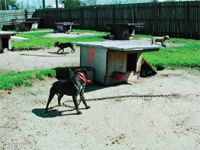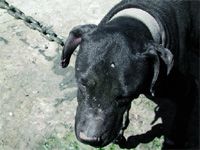The violent underworld of dog fighting
DVMs assist law enforcement, animal-welfare groups in crackdown efforts
To some people, it's an exciting sport.
To others, it's a harmless gambling enterprise.
But to most Americans, it's a shady, repugnant business they'd rather not hear about.
Opinions aside, dog fighting is a crime that seems to be on the increase, and veterinarians are joining hands with law-enforcement officials and animal-rights groups nationwide in a sweeping new effort to bring it to heel.
The American Veterinary Medical Association (AVMA) went on the offense, posting a new policy statement on its Web site specifically addressing animal fighting and urging its members to cooperate with law enforcement in curbing the practice.
Congress, too, joined the fray recently by passing the Animal Fighting Prohibition Enforcement Act, providing a three-year prison term and fines up to $250,000 for interstate and foreign animal-fighting activities. Dog fighting is a felony in all states except Wyoming and Idaho, although state penalties vary widely, from modest fines to serious jail time.
Introduced in the United States more than a century ago, dog fighting has long operated in seedy, underground venues, but some recent high-profile cases – particularly one involving an investigation at a Virginia property owned by Atlanta Falcons quarterback Michael Vick and major raids and several arrests at nine locations in southern Ohio – are shining a light on its methods and business side as never before.

John Goodwin
"It's definitely on the upswing," says John Goodwin, an investigator for the Humane Society of the United States (HSUS). That group estimates 20,000 to 40,000 people participate in what it believes is a multibillion-dollar industry each year nationwide.
The HSUS says the majority of fighting dogs are pit-bull terriers bred specifically for the blood sport and that top breeders command up to $5,000 each for a pit-bull puppy. It says an average dog fight carries a $10,000 purse, but when high-profile figures get involved the payouts can be many times that.
Veterinarians "can and do play a critical role in many of these cases by providing expert testimony on dog-fight injuries, equipment and the drugs that are used. They also help just by reporting what they see: Good veterinarians will report animal injuries and abuse from dog fights in the same way good medical doctors report suspected child abuse to the proper authorities," Goodwin says.

Dr. Gail Golab
Reporting obvious fight injuries is always the ethical thing for veterinarians to do, whether required by law to do so or not, says Gail Golab, PhD, DVM, the AVMA's associate director for animal welfare.
Seven states – Arizona, California, Georgia, Illinois, Minnesota, Wisconsin and West Virginia – require DVMs to report dog-fight injuries, with varying penalties for noncompliance, Golab says.

Bred for violence: The Humane Society of the United States (HSUS) says these fighting dogs were confiscated during a 2005 raid on a Louisiana property.
In states where reporting is not mandated, treating a suspected fight injury "can put a veterinarian in an uncomfortable predicament at times," Golab says. "A fight-dog's owner might bring it in for treatment believing the doctor won't recognize or suspect the source of the wounds, and if there is no mandate to report, or it's unclear to whom one is to report, the doctor has a predicament. But the profession has taken a position on it, as outlined in the new (AVMA) policy statement."
Few members call the AVMA for advice on dog fighting, but attorneys, law-enforcement and other regulatory officials sometimes do, Golab says.
There seem to be three separate groups in the dog-fighting world, Golab says.
"At the top, there are the seniors, or so-called professionals, involved on a national or even international scale, who selectively breed and condition dogs for fighting. They may seek a veterinarian's help if they think they can get away with it, but often they'll self-treat the animals. The dogs are of some value to them."

Dr. Dena Mangiamele
The second group, says Golab, are "the hobbyists, those who are in it for gambling, for the financial reward. Their animals tend not to be well-bred, and they are not well cared for, if at all."
So called "street fighters" make up the third group, says Golab. "Usually they're gang-affiliated, the animals they use might come from shelters or rescue groups, and they're the most abusive to their animals. They don't care for injured animals at all."
The street-fighting group in cities has been growing rapidly of late, Goodwin believes. "The boom is due largely to pop-culture influences," he says.
Golab says veterinarians in some areas, particularly urban, "are becoming more aware of fighting and better able to recognize injuries, which typically occur to a dog's face, front legs, abdomen and groin areas, usually deep puncture wounds in various stages of healing."
While dog owners might be reluctant about consulting DVMs, "sometimes another person indirectly related to fighting, a relative or someone who notices a badly injured dog, might bring the animal in for treatment. Besides obvious wounds, vets sometimes check blood-cell chemistry or run toxicology tests for evidence of steroids, diuretics or other drugs, or check for elevated muscle enzymes, all of which can help in prosecutions," Golab says.
This doesn't mean, however, there aren't DVMs and veterinary technicians who turn a blind eye to dog fighting or even are present at some fights, Goodwin says. "A winning dog is a valuable asset to its owner, and those owners are more likely to want professional treatment for their animals, either right on the spot or shortly after. I know of instances where vets were present at fights, but more often it's technicians who are paid to be there to treat the wounded."
Still, "the majority of veterinarians I've talked to will do what they can to stop dog fighting," Goodwin says. "One practice I heard about but can't recall the name even advertised the fact that it would not accept any dog-fight patients; word of that quickly got around among the criminal element."
Goodwin explains that DVMs are a major help to prosecutors, "because they are credible experts on fight injuries – they know a fight injury from one that occurred when a dog crawled under a barbed wire or thorn bush – or whatever else a defense might concoct – and they know what the drugs that are confiscated are used for."
One veterinarian who has testified in or consulted on numerous dog-fight prosecutions is Dena Mangiamele, who operates a private consulting service in San Diego – Animal Legal and Veterinary Consulting Services. She formerly served as chief veterinarian for the Los Angeles Department of Animal Regulation, and as animal-control director for San Diego County.
Helping collect evidence at raids, preparing a thorough case and then testifying "is dangerous business," Mangiamele tells DVM Newsmagazine. "Going to some of these places is scary; it places you in danger. Besides the animal abuse, there often are weapons, gambling and drugs involved."
"Good preparation is the key" to winning a case," Mangiamele says. "You always have to stay a couple of steps ahead of them (the defense)."
She has testified in dog-fight cases in California, Nevada and New York, and consulted on a case in Louisiana.
Good preparation, she says, includes visiting the site of the raid if possible, examining the dogs's injuries – typically on the head, neck, chest and front limbs, almost never the rear limbs – looking at photographs taken when they were impounded, "getting to really know these animals – which might have been impounded eight or 10 months earlier. You can't be taken off-guard or taken by surprise by the defense. You have to anticipate what they'll argue," Mangiamele says.
"They might say that it's an injured show dog or the animal was injured in a pull contest, was raked by a boar's tusk, or that equipment such as treadmills (used to strengthen fighting dogs' stamina) or substances like steroids were used in a legal context. I've heard it all and can rebut all of it."
Mangiamele says she prepares statistics on each dog in a case, then selects the two or three worst injuries that she can speak about in trial without notes. "I have as many specific facts and figures at hand as I can. I also advise the prosecution on pharmaceuticals that were confiscated, the amounts and what they're used for. Sometimes defendants have multiple cases of fluids, or a big store of staples or suturing material. It's the quantity that gives them away as fighters despite whatever creative excuses they come up with for having those large stores. This level of preparation almost always blows away the judge and jury."
Besides her trial work, Mangiamele also is a consultant for the HSUS and has helped train DVMs, particularly shelter vets, in several states to recognize and prosecute dog fighters.
Someone like Mangiamele – a DVM with good forensic knowledge – "definitely will be needed in the case in Virginia," Goodwin says. "Both sides will pull out all the stops."
It turns out that one of the nation's top forensic veterinarians – Dr. Melinda Merck of Canton, Ga. – has been assigned to the Virginia case as a representative of the American Society for the Prevention of Cruelty to Animals (ASPCA), according to Dr. Randall Lockwood, senior vice president of Anti-Cruelty Initiatives and Legislative Services for the ASPCA in Washington, D.C.
Lockwood is Merck's supervisor at ASPCA, although she operates a consulting service on cruelty cases. (Lockwood, an animal behaviorist, also has worked with authorities during raids and has taught courses at veterinary conferences on animal-cruelty issues and dog fighting. See related story on p. 34.)
Merck, who was unavailable for an interview with DVM Newsmagazine, will assist the Surry County sheriff's staff and (Virginia) Commonwealth Attorney Gerald Poindexter on the case. She told reporters she couldn't comment on her specific role.
During an April drug raid on Vick's property in Surry, a small rural community in southeastern Virginia, investigators reportedly found 66 dogs – 55 of them pit bulls – in the backyard, some in kennels and some tethered with heavy chains.
Also reportedly found were a rape stand, used to hold non-receptive dogs in place for mating; a treadmill; a pry bar used to open the mouths of dogs when they have clamped shut while biting; and a bloodied piece of carpeting. Experts say carpeting is sometimes used to give dogs traction in a fighting arena.
Vick, a registered dog breeder, told the Atlanta Journal-Constitution, "I'm never at the house. I left the house with my family members and my cousin. They just haven't been doing the right thing." The house reportedly was put up for sale shortly after the raid.
Vick is a native of Newport News, Va., and played college football at Virginia Tech. He has refused comment on the case on his attorney's advice, other than to state that he was unaware of any alleged illegal activity there.
ESPN.com, however, quoted a confidential source as saying that he'd seen Vick at dog fights, describing him as "one of the heavyweights."
At press time, federal authorities seemed to be taking control of the case, assisted by Virginia police in executing a search warrant at the property. A local search warrant expired before it could be executed.
That raised questions as to whether any prosecution that takes place would be handled at the federal level, or by Poindexter and local authorities. For the case to come under federal jurisdiction, there would need to be evidence of criminal activity across state lines. Goodwin says he believes that did occur.
Poindexter said he had not filed any charges to date because investigators so far had not produced any solid evidence linking Vick to dog fighting. Under Virginia law, dog fighting is a felony that carries a maximum five-year jail term. Poindexter said some informants had come forward, and his investigation was ongoing.
"This process will not be driven by people who hate Michael Vick, people who love Michael Vick or by people who love animals," Poindexter told an Atlanta reporter. He questioned whether federal authorities would even look into the matter if the name of a high-profile personality were not attached to it.
Poindexter said some erroneous reports had surfaced, including one that the dogs found were malnourished and that many bore scars and injuries apparently stemming from fights. Actually, he told reporters, the animals seemed reasonably well cared for.
Animals seized at the Virginia property reportedly are being held in kennels around the area until the case is completed. After that, they are likely to be euthanized. Goodwin says that dogs captured in almost all fighting cases must be put down because their in-bred or trained aggression makes them unfit for adoption as pets.
In a separate case, nine men were indicted in southern Ohio in late March in what was described as part of the federal government's largest-ever dog-fighting bust, following a raid on nine locations in the Dayton and Cincinnati areas, Goodwin says. The nine face 47 counts related to dog fights, gun-running and drug trafficking.
The case may help expose the growing incidence of dog fighting and crimes often related to it, authorities say.
Ohio Attorney General Marc Dann was present during one raid, at a warehouse in Moraine, Ohio, where about 25 men, women and children showed up, expecting to see a dog fight. "It almost looked like a gambling casino," Dann told reporters. "There was a concession stand set up, and a fighting pit. It was really kind of surreal to see."
In the raids, agents arrested 24 people and seized 64 dogs as part of a 14-month investigation that also reached parts of Indiana, Kentucky, Pennsylvania and Michigan.
The cases currently are working their way through the legal system, Goodwin says.
Dog fights "are so violent that dogs have had their jaws broken and have bled to death in the pit," Goodwin says, adding that fighters keep looking for ways to make them even more violent, citing the example of an underground video "that shows an owner using a rotating power tool like a sander to sharpen the canine teeth of a sedated dog. I don't know how common that is, but what these people dream up never ceases to amaze me."
4 signs that dog injuries occurred in illegal fight
By James M. Lewis
MANAGING EDITOR
What are some tell-tale signs to alert veterinarians that dogs presented for treatment likely sustained their injuries in a staged fight?
Dr. Randall Lockwood, an animal behaviorist and senior vice president for anti-cruelty initiatives and legislative services for the American Society for the Prevention of Cruelty to Animals (ASPCA), tells DVM Newsmagazine that one or more of the following four conditions should raise a red flag:
1.The nature of the injuries – typically on the face, front legs (rarely the rear legs), chest and abdomen. Facial injuries, Lockwood says, usually are "multiple puncture wounds that look like scattered buckshot." On the front legs, pieces of skin may have been pulled away in a ring-like pattern, as if pulled away by a wire, caused by another dog's attempt to flip its opponent onto its back.

Typical injuries: Fighting dogs often have scatter-shot puncture wounds to the head and face in various stages of healing, experts say.
"In an ordinary, neighborhood dog fight," Lockwood says, "one dog may turn belly-up to show submission and that usually ends the fight. But that trait seems to have been bred out of these animals. They try to turn each other over, so there may be severe bite wounds on the chest and abdomen. Also, you'll see wounds in various stages of healing – fresh ones, recent ones that may appear pink in color and some old wounds that have healed."
2.Third-party payments, and payments in cash. Owners of valuable fighting dogs, Lockwood says, rarely bring their animals to veterinarians in person. They send someone else who can claim they don't have direct knowledge of how the dog was injured, or passes along a false explanation, and wants to pay for services in cash even when it's a significant amount.
3. Explanations of injuries that are inconsistent with what the veterinarian sees. "They may say the dog ran through a storm-door glass, or through a rose bush," Lockwood says. "In some areas, particularly in the South, a veterinarian may be told that a fight dog was injured during a pig hunt (wild boar) or while hunting bear. But a boar's tusk causes knife-like wounds, not puncture wounds, and a bear's claws produce deep scratches inconsistent with fight injuries."

Dr. Randall Lockwood
4.Requests for treatment supplies for home use. "If the client asks for surgical supplies, solutions like saline or even for controlled substances like steroids, that's usually a clear tip-off that they're involved in dog fighting," says Lockwood.
Seven states require veterinarians to report suspected dog-fighting injuries to authorities – Arizona, California, Georgia, Illinois, Minnesota, Wisconsin and West Virginia.
"The majority of other states provide immunity to veterinarians for good-faith reporting," Lockwood says. "My impression has been that most of them report it anyway for ethical reasons – they do it to protect animals and people. Some may say you alienate clients that way, but do you want dog fighters as clients? These people are not model clients."
Animal-fighting law takes effect
President Bush signed into law on May 3 the Animal Fighting Prohibition Enforcement Act, aimed at cracking down on organized dog fighting and cockfighting.
The Senate one month earlier approved by unanimous consent H.R. 137, making animal fighting a felony and providing for up to three years' jail time and a maximum $250,000 fine for violations. The House passed the measure on March 26 by a vote of 368-39.
The original Senate bill, H.R. 261, was introduced by Sens. Maria Cantwell (D-Wash.), veterinarian John Ensign (R-Nev.), Arlen Spector (R-Pa.) and Dianne Feinstein (D-Calif.)
The legislation was under consideration and debate for nearly six years. It took effect immediately with Bush's signature.
Ensign issued a statement saying, "As a veterinarian, I know animal fighting is a cruel form of entertainment, and this bill will take a great step toward stopping it. Animals associated with these fights can spread disease to other animals and even humans. Animal fighting is a barbaric practice, and individuals participating in these acts often are associated with other criminal activities."
The AVMA's policy
The American Veterinary Medical Association (AVMA) last month posted this new policy statement on its Web site specifically addressing animal fighting:
"The AVMA condemns events involving animals in which injury or death is intended. The AVMA supports the enforcement of laws against the use and transport of animals and equipment for fighting ventures. Further, the AVMA recommends that animal fighting be considered a felony offense. The AVMA encourages veterinarians to collaborate with law enforcement with respect to recognition, enforcement and education.
Louisiana legislation takes aim at cockfighting
Pending bills would ban the practice, differ on effective dates
By Krista Schultz
ASSOCIATE EDITOR
BATON ROUGE, LA. — Louisiana is the only state where cockfighting remains legal, but the practice could be banned there as well if pending legislation is passed this summer.
Cockfighting opponents had until the end of the 2007 legislative session (June 28) to encourage House and Senate members to approve one of two complementary bills outlawing the practice.
Backed by Louisiana Sen. Arthur "Art" Lentini and Rep. Harold Ritchie, respectively, the two bills remained in limbo at press time.
"If I had to guess, I'd say the sense of the legislature is to have a ban of some form. The question is just when is it effective? I am doubtful we will come out of session without some ban. But I've been wrong before," Lentini says.
"It is just extremely cruel to animals to have to fight for the amusement of human beings and for gambling purposes. It is a real black-eye for Louisiana to be the only state that permits this," he says.
Lentini's bill seeks an effective date in August, while Ritchie's legislation would ban the practice a year later, in August 2008.
Willing to arrange a compromise, Lentini said he would support an immediate ban on cockfighting gambling, followed by a cessation of the practice by year's end. "I would accept that, but I'd like to have an immediate ban to both."
Criticized by constituents for "worrying about chickens" when he should be focused more important issues, such as legislation to help repair the state after the 2005 hurricanes, Lentini says he stands by the importance of the anti-cockfighting bills. "Most states started banning this over 200 years ago," he says. "We're not even in line with the 19th century."
DVMs team up with pediatricians, postal workers to collar dog bites
SCHAUMBURG, ILL. — Some 4.7 million people were bitten by dogs last year, a trend the American Veterinary Medical Association is trying to muzzle.
The association teamed up with U. S. Postal Service employees and the American Academy of Pediatrics (AAP) to sponsor Dog Bite Prevention Week, May 20-26, 2007.
"It was hugely successful. It hit different audiences, so I think we're really getting the message out there," says Sharon Curtis Granskog, AVMA's assistant media- relations director.
Radio programs on dog-bite prevention, featuring Animal Planet's Kevin Fitzgerald, DVM, are believed to have reached 62 million people, and an AVMA, AAP and postal service-circulated brochure, titled "What You Should Know About Dog Bite Prevention," provided additional publicity.
"The only cure for dog bites is prevention," says AVMA President Roger Mahr. "Any dog can bite if it feels threatened, if it's put into an unfamiliar situation, if it's out of control, or if it's scared." Training, knowledge and caution are essential, he says, adding that "responsible pet ownership and education are keys to reducing the number of bites that occur in a community."
Next year, AVMA hopes to get the American Academy of Plastic and Reconstructive Surgeons and the Emergency Nurses Association involved, Granskog says.
Prevention tips and facts are available on AVMA's website.